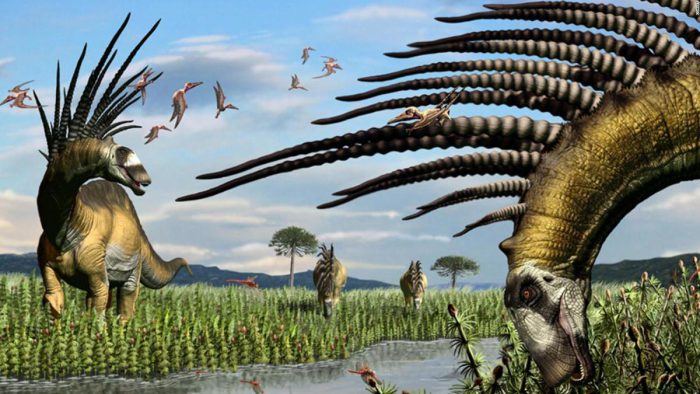If there's one thing that we've learned not to second guess, it's just how strange dinosaurs actually were. Remember when we thought that dinosaurs didn't have feathers? Haha, that was so silly! Of course some did!
In this way, one of the more exciting groups of dinosaurs that scientists are discovering are the dicraeosaurs (say dih-KRAH-eeo-sawrz). These are a group of sauropods (a.k.a. the long-necked giants) that have rows of spines behind their head and down their neck. It is a lesser known group ... but the latest addition to it certainly has our attention.
(Getty Embed)
It is called Bajadasaurus pronuspinax (say bah-HA-dah-saw-rus proh-new-SPI-nahks). From the moment paleontologists first found its fossil in Patagonia in South America, they knew they were looking at one wild-looking animal. The main question?
Exactly how wild?
Spikes or sail?
Even for a dicraeosaur, the Bajadasaurus is a strange customer. Its spines are enormous, leading to some debate about what the animal actually looked like. Did these spines support a 'sail' that the animal used to regulate its body temperature? Or were these more like spikes?
In the end, scientists settled on them being horns that were used for defense. One look at this recreation and you get the picture.
A restoration of the Bajadasaurus. (Getty Embed)
What predator in their right mind would want to mess with that?
Covered in keratin
The horns on the Bajadasaurus may have looked similar to those of these impalas. (Getty Embed)
Essentially, the Bajadasaurus was like about ten antelope heads on one creature. For protection against being easily broken, scientists believe that these horns would've covered by keratin—the same substance that protects the horns of antelopes.
Were the horns also used in mating displays to other Bajadasauruses? Did the creatures actively use them to ward off predators? Or did they kind of just sit there looking really scary on their back? These questions are much together to answer. A fossil can give real clues to an extinct animal's behaviour, but it's not a time machine.
Regardless, there is little doubt that Bajadasaurus is the most punk rock dinosaur we've seen in a while. Keep those freaky fossil coming, science!
 Meet perhaps the gnarliest dinosaur yet: Bajadasaurus! (Jorge A. González)
Meet perhaps the gnarliest dinosaur yet: Bajadasaurus! (Jorge A. González)









